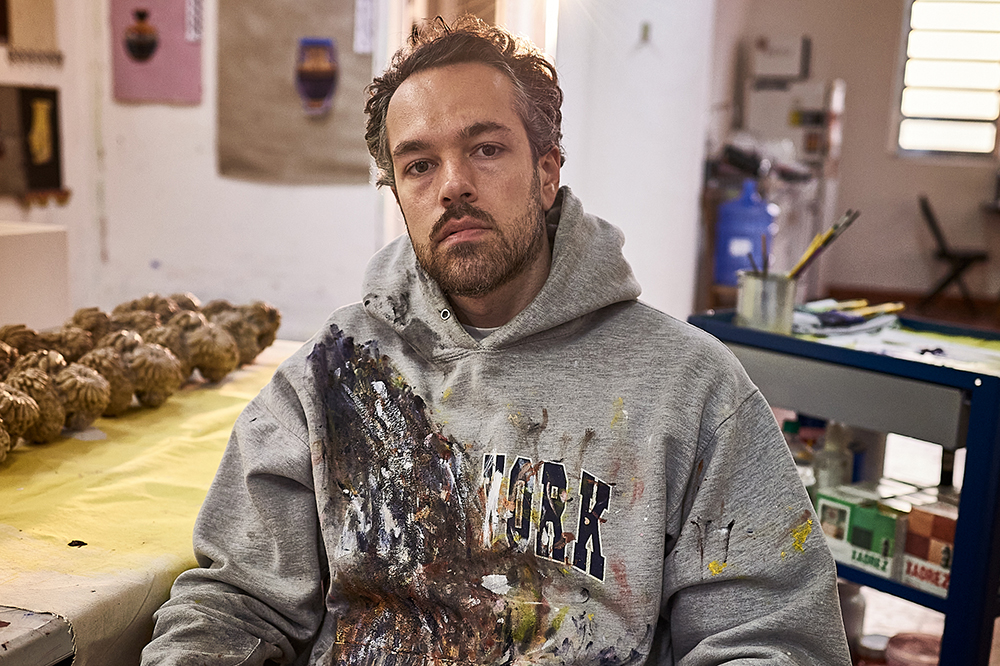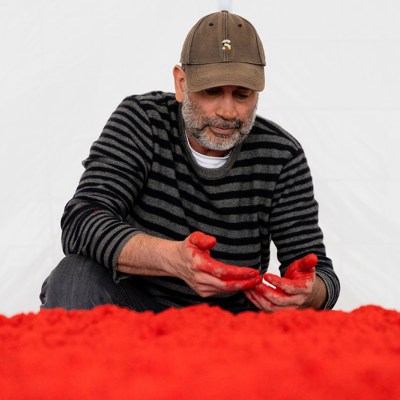The Brazilian artist Paulo Nimer Pjota paints onto unstretched canvas and found sheets of metal collected from the streets of São Paulo, creating tactile, layered surfaces that the artist hangs alongside sculptural objects in shrine-like assemblages. His work encompasses a wide range of references – from ancient civilisations and myths to recollections of his childhood in rural Brazil. ‘If you think of the composition, you can imagine a rapper, sampling and repeating to produce the beat. I do it with my pieces: I cut a part of the history and reproduce, cut another part and reproduce,’ he has said of his working process. A solo exhibition of his recent work is at Maureen Paley, London, until 24 April.
Where is your studio?
In a very old neighbourhood in São Paulo. It’s not the place where most galleries and artists are – it’s known more as the workers’ neighbourhood. When I first moved here, six or seven years ago, I was looking for somewhere that I could live and work and chose this place mainly because it wasn’t too expensive, but I love the neighbourhood – it has a very interesting history. Now, I live ten minutes away so I can walk here each day.
How have you found living and working in the area?
It was pretty intense. I lived here for around five years when I was also sharing the studio with three other people. I finally found an apartment that I liked and the separation is good for me: I don’t keep anything related to my work at home, but it’s also easy for me to come to the studio when I need to work.
Photo: Ana Pigoso. Courtesy the artist and Maureen Paley, London

How does being in São Paulo influence your work?
The view from my window is what I think of as the typical São Paulo landscape: I can see a mix of small houses and tall buildings. The street is on a hill so it’s slightly above the level of the city and nothing interrupts the view – it’s very beautiful. I grew up in the countryside of Brazil, in a place about five hours from São Paulo. When I moved here, I brought with me memories of the countryside, like the colour of the walls. In Brazil, it’s common to use a paint called cal which you mix with pigment. It’s not super high quality so when you use it on the outside walls of a house, the colour fades quite quickly and you get all these different textures. I was already using those kinds of colours and techniques in my work; when I moved to São Paulo, I started to notice things about the city that I could also incorporate – like the stickers you see on motorcycles or the [graffiti] tags that are used by criminal gangs. I travel a lot so I draw on those experiences too.
What’s the weirdest object in your studio?
I buy and collect lots of different things, most of which are stored on the second floor of the studio. I don’t know which is the weirdest, everything is a little bit weird – like the porcelain joint that I created for my show at the Power Station in Dallas.
Jardim alquímico de dia (2022), Paulo Nimer Pjota. © Paulo Nimer Pjota, courtesy Maureen Paley, London

What do you like most about your space?
The size, and also that it’s a quiet neighbourhood. I tend to work on ten or more paintings at a time because I’m usually thinking about a solo show and the works need to go together as a group so space is very important to me.
Do you listen to anything while you work?
I listen to music everyday. Luckily, my assistant Fabio and I have similar taste. We listen to hip hop, Brazilian funk and jazz, sometimes podcasts. I think music is the most important thing in my life – it’s the way I ground myself in the world, politically and socially. Everything started with music, right down to the clothes that I wear.
What’s your typical studio lunch?
A very traditional Brazilian lunch: rice and chicken, or another kind of meat. Nothing very special. Sometimes, I cook in the studio or bring something from home. There are some nice restaurants around here, but I like to eat healthily.
3 reis magos part. 2 (2017), Paulo Nimer Pjota. © Paulo Nimer Pjota, courtesy Maureen Paley, London

Do you pin up images of other artists’ work?
Not really. I have a lot of artist books, but I try to keep the space organised because I use so many references in my work – objects, images, things from history – and I don’t want to lose my focus.
What does your studio smell like?
I’ve never really thought about that before… It doesn’t really smell like a painting studio – probably because it’s so big. Sometimes, I burn incense or when I’m feeling tired or not so creative, I light candles. My process is very spiritual. I’m not that open to lots of people visiting the studio – it’s where I spend a lot of time: it’s my life.
Do you have any studio rituals?
I am usually in studio from 10am to 6pm, every day. When I arrive, the first thing I do is to make sure everything is in the right place. When we finish work in the evening, my assistant and I clean and put everything away, but I am very organised and I don’t like to stop when I am painting so the space has to be tidy. Sometimes, in the mornings or the evenings, I also put out candles for the gods that I believe in.
‘Paulo Nimer Pjota’ is at Maureen Paley, 60 Three Colts Lane and Studio M, Rochelle School, London, until 24 April 2022.



